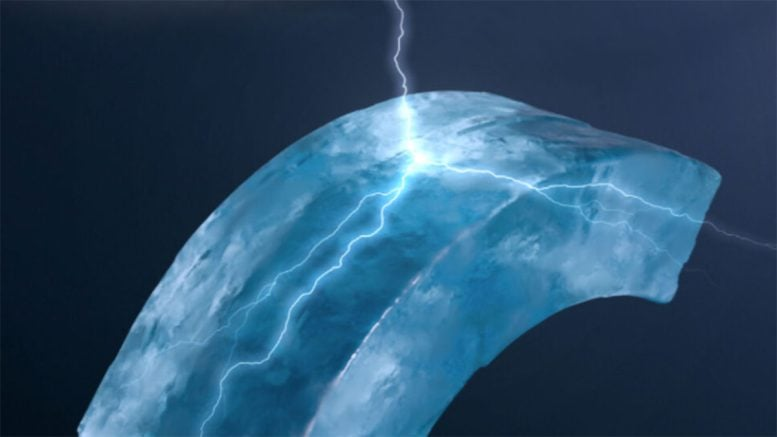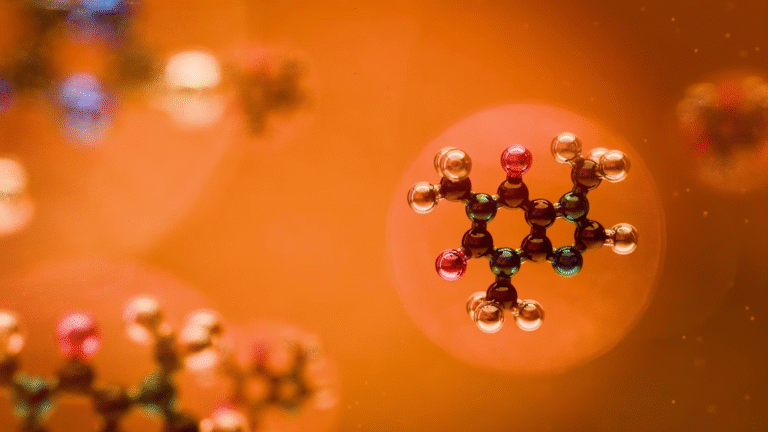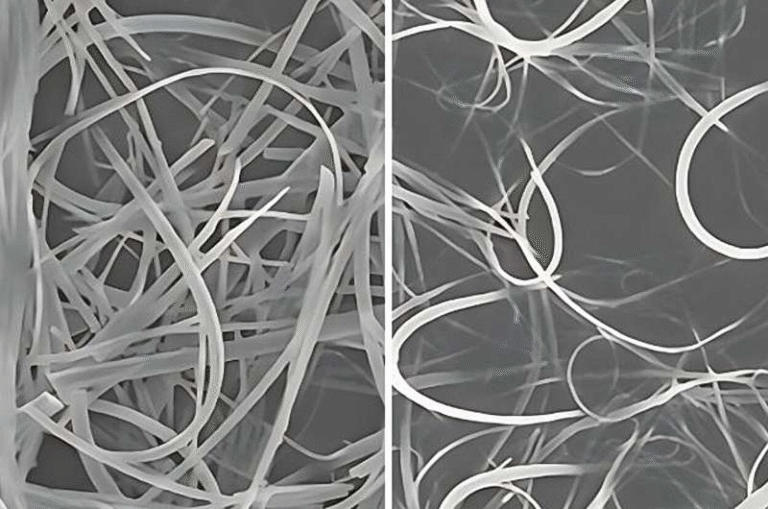Scientists Discover Electricity in Ordinary Ice When It Bends

Scientists have recently revealed something unexpected about ordinary ice—it can generate electricity when bent or deformed.
This discovery not only challenges what we thought we knew about one of the most common substances on Earth but also opens the door to understanding natural events like lightning and to designing new technologies. The research, published in Nature Physics, shows that ice has two different ways of producing electricity depending on temperature.
Flexoelectricity in Ice
The main phenomenon at the center of this discovery is flexoelectricity. This is the ability of a material to produce an electrical charge when it is bent or unevenly deformed. It is different from piezoelectricity, where materials generate electricity when compressed or stretched. Ice has never been known to be piezoelectric, but this new study confirms that it is indeed flexoelectric.
The team behind the discovery included scientists from ICN2 at the Universitat Autònoma de Barcelona, Xi’an Jiaotong University in China, and Stony Brook University in New York. They demonstrated, for the first time, that regular hexagonal ice (known as ice Iₕ) generates electrical potential when mechanically bent.

What makes this more remarkable is that the flexoelectric effect observed in ice is comparable to well-known electroceramic materials like titanium dioxide (TiO₂) and strontium titanate (SrTiO₃), which are already used in advanced sensors and capacitors. This means ice, a substance we encounter daily, shows an electromechanical response similar to high-tech engineered materials.
Ferroelectric Surface Layer
In addition to flexoelectricity, the researchers discovered another property at very low temperatures. When cooled below 160 K (−113 ºC), ice develops a ferroelectric surface layer. This means that the very thin “skin” of ice at the surface can have a natural electrical polarization, and this polarization can be reversed by applying an external electric field.
This is similar to how the poles of a magnet can be flipped. Although this ferroelectric effect occurs only at very low temperatures, it represents a second way that ice can generate electricity—in addition to flexoelectricity, which works up to the melting point of ice (0 ºC).
Implications for Lightning
One of the most intriguing aspects of this research is its potential to explain how lightning forms during thunderstorms. It has long been known that lightning results from electrical charges building up in storm clouds, largely due to collisions between ice particles. However, the actual mechanism by which these ice particles become electrically charged has been unclear.
Since ice is not piezoelectric, simple collisions or compression could not explain the charges observed in clouds. Now, with the discovery that ice is flexoelectric, scientists propose that inhomogeneous deformations—in other words, when ice particles bend or deform irregularly during collisions—can generate electrical charges.
The researchers measured the potential generated by bending slabs of ice and found that the values matched those observed during ice-particle collisions in thunderstorms. This strongly supports the idea that flexoelectricity could be a key contributor to the charge buildup that eventually leads to lightning.
Testing the Effect in the Lab
To test the flexoelectric effect, the scientists placed slabs of ice between two metal plates connected to a measuring device. When they bent the ice, it produced a measurable electrical signal. This confirmed that the charges were not just theoretical but could be observed and measured directly.
This type of laboratory experiment not only confirms the theory but also demonstrates how everyday materials like ice can hold unexpected physical properties.
Salty Ice and Stronger Effects
After discovering flexoelectricity in pure ice, the researchers expanded their work to test saline ice—ice that contains salt. This follow-up study, published in Nature Materials, revealed something even more dramatic.
By adding sodium chloride (NaCl) at around 25% concentration, they found that the flexoelectric coefficient of ice was boosted by up to a thousand times. Instead of generating charges at the nanocoulomb-per-meter scale (as in pure ice), saline ice produced charges in the microcoulomb-per-meter range, which is comparable to the strongest piezoelectric materials used today.
The explanation lies in what the scientists call a streaming current mechanism. When saline ice is bent, liquid brine trapped in grain boundaries moves from compressed areas toward stretched areas, dragging mobile ions with it. This movement creates a large electrical current, amplifying the flexoelectric effect.
Using this mechanism, the team even built prototype devices that showed an effective piezoelectric coefficient of about 4,000 pC/N, rivaling the best piezoelectric materials available.
This shows that by tuning the composition of ice, its electromechanical properties can be enhanced to a level that might actually be useful for real-world applications.
Potential Applications
The idea of using ice as a functional material might sound odd at first, but the discovery opens up possibilities:
- Energy harvesting: Devices that could generate small amounts of electricity from ice deformations in cold environments, like the Arctic or Antarctic.
- Sensors: Ice-based electromechanical sensors might be possible for monitoring structural changes in glaciers or detecting pressure in frozen environments.
- Planetary science: Understanding the electromechanical properties of ice may help explain processes on icy moons such as Europa or Enceladus, where briny ice is common.
The researchers note that while these applications are still far from reality, the principle has now been demonstrated.
The Bigger Picture: Ice in Everyday Life and Nature
Ice is one of the most common materials on Earth. It forms glaciers, ice caps, and sea ice, and it shapes landscapes through freeze-thaw processes. Despite its familiarity, it continues to reveal new behaviors under scientific investigation.
There are actually 18 known crystalline forms of ice, depending on the conditions of temperature and pressure. The most common form on Earth is ice Iₕ, the hexagonal arrangement studied here. But in the deep interiors of planets or moons, high-pressure forms of ice exist that may have their own unusual physical properties.
The discovery of flexoelectricity and surface ferroelectricity in ice adds to this long list of surprises.
Why This Discovery Matters for Science
For physicists and materials scientists, this finding is significant because it shows that a material as simple and familiar as water ice can behave like advanced engineered ceramics. It also provides a potential missing piece in the puzzle of lightning generation, one of nature’s most dramatic and least understood processes.
For atmospheric scientists, it offers a new mechanism to study in cloud electrification. For engineers, it points to new possibilities in designing devices that can work in extreme cold.
Open Questions for the Future
While this discovery is exciting, there are still many questions left unanswered:
- How strong is the contribution of flexoelectricity to lightning overall? Cloud electrification is complex, and multiple mechanisms may be involved.
- Can these effects be scaled for practical technology? Making devices out of ice may sound impractical, but the saline ice findings suggest there could be ways forward.
- What about other impurities? Salt is just one additive. Other natural impurities in ice, such as dust or organic material, may also influence its electromechanical properties.
- What role could this play on icy moons? With vast oceans under thick ice shells, bodies like Europa or Enceladus could be natural laboratories for such effects.
Beyond Flexoelectricity: Interesting Facts About Ice
To make this story even more complete, here are a few more facts about ice that are worth knowing:
- Ice is less dense than water, which is why it floats. This anomaly of water is essential for life because it allows lakes and oceans to freeze on the surface while staying liquid underneath.
- Glaciers move because of both plastic deformation and sliding over their base. The discovery of electrical effects in ice could add another layer to how scientists study glacier dynamics.
- Electrical phenomena in ice have been studied before, such as the “ice rules” governing hydrogen bond arrangements. The new discoveries add electromechanical coupling to this field.
- Polar ice caps on Mars and icy surfaces of outer solar system bodies may exhibit similar properties. If lightning-like discharges occur there, flexoelectricity could be part of the explanation.
Final Thoughts
The discovery that ice can generate electricity when bent changes how we see one of Earth’s most familiar substances. With its dual ability—flexoelectricity at higher temperatures and ferroelectricity at very low temperatures—ice joins the ranks of materials once thought to be only artificial or exotic.
Combined with the finding that salty ice can amplify these effects by orders of magnitude, this research not only improves our understanding of natural phenomena like thunderstorms but also sparks ideas about new technologies in cold environments and even beyond our planet.
For now, this is a reminder that even the most ordinary materials around us may hold extraordinary secrets waiting to be discovered.
Reference: Flexoelectricity and surface ferroelectricity of water ice – Nature Physics (2025)





